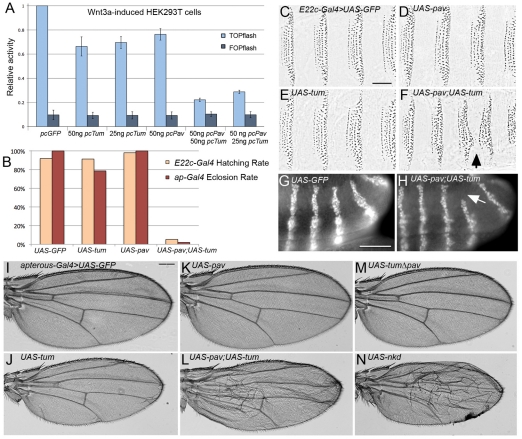Fig. 2.
Tum and Pav act more strongly when coexpressed. (A) Minimal doses required for statistically significant repression are 25 ng Tum (P=0.01) and 50 ng Pav (P=0.02). Tum and Pav together at these doses repress TOPflash activation to 29% of vector alone controls (P=0.0002). This repression is also significantly different when compared with repression by Tum alone (P=0.005) or Pav alone (P=0.005). Results are means ± s.d. (B) Overexpression of Tum or Pav in the embryonic epidermis, with E22c-Gal4, or in the dorsal domain of wing imaginal discs, with apterous-Gal4, has no effect on embryonic hatching rate or adult eclosion rate respectively. Co-expressing Tum and Pav dramatically decreases both rates (n>200 fertilized eggs for each hatching experiment, n>100 balancer siblings from each ap-Gal4/CyO cross). E22c-Gal4-driven UAS-GFP (C), UAS-pav (D) or UAS-tum (E) does not affect epidermal patterning. Co-expression of both transgenes (F) variably reduces the naked cuticle expanse (arrow) to cause denticle belt fusions (22.5%, n=223). Penetrance of this segmentation defect is increased when embryos are heterozygous for the wgCX4-null allele (81.1%, n=132). (G) No disruption of the striped en expression is detected when UAS-GFP was driven in the wg heterozygous background (n>100). (H) In the sensitized wg heterozygous background, defects in the segmental expression of en (arrow) can be detected when UAS-pav and UAS-tum are coexpressed with E22c-Gal4 (29.8%, n=161). Without the sensitizing wg heterozygosity, virtually no defects in en expression can be detected when UAS-pav and UAS-tum are coexpressed (1.2%, n=160), indicating that cuticle pattern is a more sensitive assay for Wg activity. ap-Gal4-driven UAS-GFP does not affect wild-type wing patterning (I), whereas ap-Gal4-driven UAS-tum (J) consistently reduces the overall size of the wing. This phenotype is not shared by UAS-pav (K). ap-Gal4 driving both transgenes simultaneously killed most animals before or during pupation. (L) The few escapers (n=3) consistently show wings that are reduced in size and blistered. (M) ap-Gal4-driven UAS-tumΔpav does not reduce wing size. (N) ap-Gal4-driven UAS-nkd produces wing pattern defects similar to those observed with Tum-Pav coexpression (L). Scale bars: 50 μm (C-H); 100 μm (I-N).

